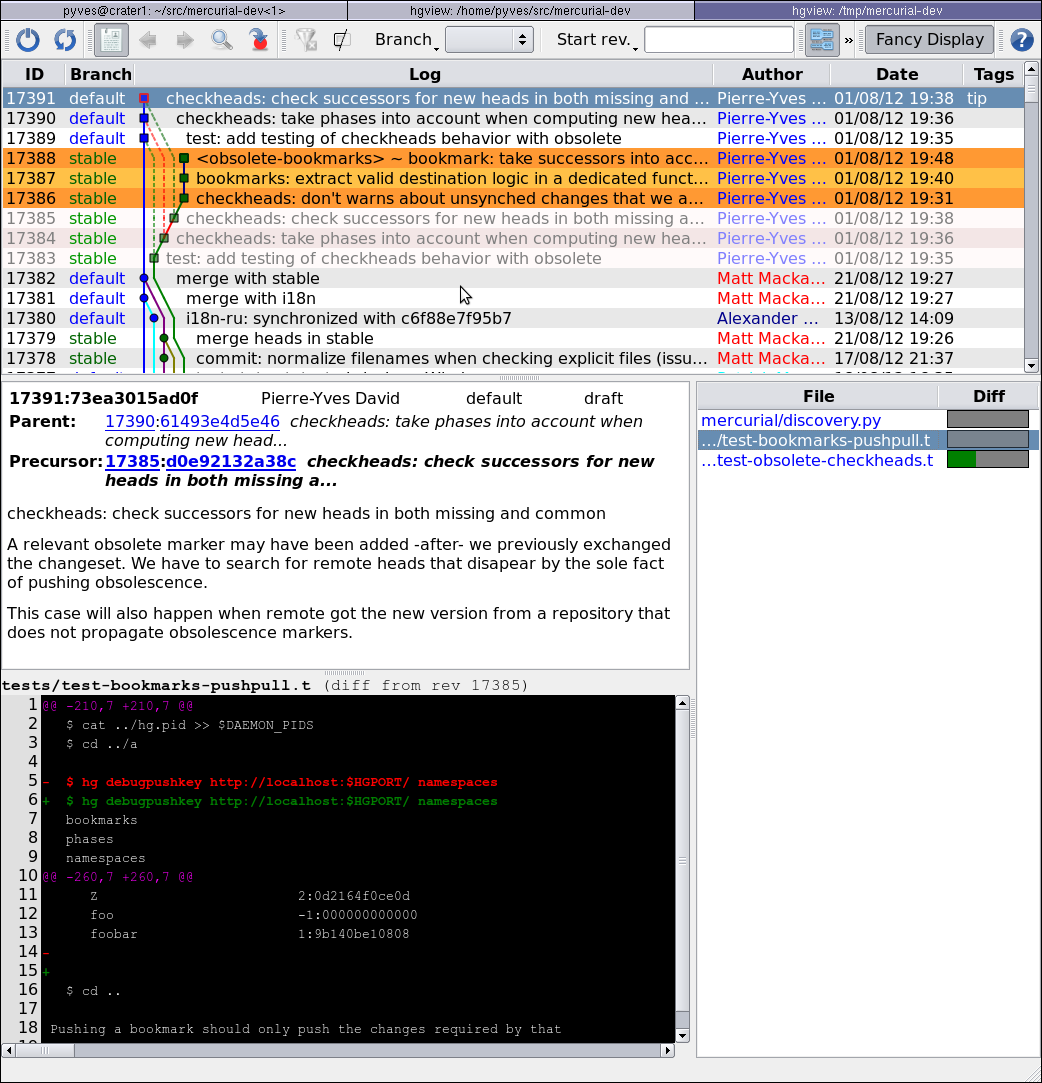Evolve How To¶
Add a changeset: commit¶
Just use commit as usual. New changesets will be in the draft phase.
Rewrite a changeset: commit --amend¶
It writes a new changeset combining working-directory parent changes and parent. It will work on any draft or secret changeset. It will not work on public changesets.
To understand what the result of amend will be I use the two following aliases [1]:
# diff what amend will look like
pdiff=diff --rev .^
# status what amend will look like
pstatus=status --rev .^
This command can even be invoked on changesets with children, provided none are public.
| [1] | (defined by the evolve extension for you) |
Move a changeset: grab¶
You can use hg grab <rev> to move a rev at your current location, making the old version obsolete.
Note
grab is an alias for hg rebase --dest . --rev $@; hg up <result>
Delete a changeset: prune¶
A new prune command allows removing a changeset.
Just use hg prune <some-rev>.
Moving within the history: gdown and gup¶
While working on mutable part of the history you often need to move between mutable commits.
You just need to use standard update to work with evolve. For convenience, you can use hg gup to move to the child commit or hg gdown to move to the parent commit.
Those command have previous and next alias.
Note
Those commands only exist for the convenience of getting qpush and qpop feeling back.
Collapse changesets: fold¶
You can use hg fold to collapse multiple changesets in a single one.
It takes two forms:
hg fold <rev> folds everything from you current changeset to <rev>
hg fold -r <revset> fold everything changeset matching the revset together.
Getting changes out of a commit¶
The hg uncommit command lets you rewrite the parent commit without selected changed files. Target files content is not altered and appears again as “modified”:
$ hg st
M babar
M celestine
$ hg commit babar celestine
$ hg st
$ hg uncommit celestine
$ hg status
M celestine
Split a changeset¶
To split on file boundaries, just use uncommit command.
If you need a fine-grained split, there is no official command for that yet. However, it is easily achieved by manual operation:
### you want to split changeset A: 42
# update to A parent
$ hg up 42^
# restore content from A
$ hg revert -r 42 --all
# partially commit the first part
$ hg record
# commit the second part
$ hg commit
# informs mercurial of what happened
# current changeset (.) and previous one (.^) replace A (42)
$ hg prune --new . --new .^ 42
For more complexe scenario we recommend the use of the histedit extension.
Update my current work in progress after a pull¶
Whenever you are working on some changesets, it is more likely that a pull will, eventually, import new changesets in your tree.
And it is likely that you will want your work in progress changesets to be rebased on the top of this newly imported subtree.
Doing so is only a matter of rebasing.
Move multiple changesets: rebase¶
You can still use rebase to move a whole segment of the changeset graph together.
Warning
Beware that rebasing changesets already obsolete will likely result in content-divergent versions of the changesets.
Resolve history instability: evolve¶
When you rewrite (amend) a changeset with children without rewriting those children you create orphan changesets and suspended obsolete changesets.
When you are finished amending a given changeset, you will want to declare it stable, in other words rebase its former descendants on its newest version.
You can also use evolve to solve phase-divergent and content-divergent changeset/
Fix my history afterward: prune -n¶
Sometimes you need to create an obsolescence marker by hand. This may happen when upstream has applied some of your patches for example.
You can use hg prune <old-changeset> --successor <new-changeset> to add obsolescence marker.
View diff from the last amend¶
An odiff alias have been added by enable.sh
- ::
- [alias] odiff = diff –rev ‘limit(predecessors(.),1)’ –rev .
View obsolescence markers¶
hgview is the only viewer that currently supports this feature. You need version 1.6.2

You can also use a debug command
- $ hg debugobsolete
- 5eb72dbe0cb4 e8db4aa611f6 c4cbebac3751 4f1c269eab68
Important Note¶
View change to your file¶
Extinct changesets are hidden using the hidden feature of mercurial.
Only hg log and hgview support it, other graphical viewer do not.
You can use hg log --graph --hidden from the command line